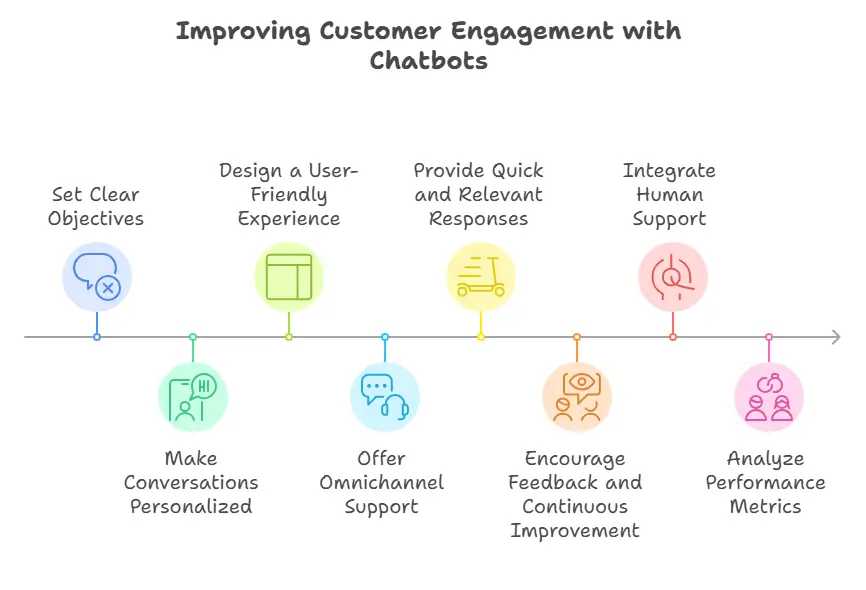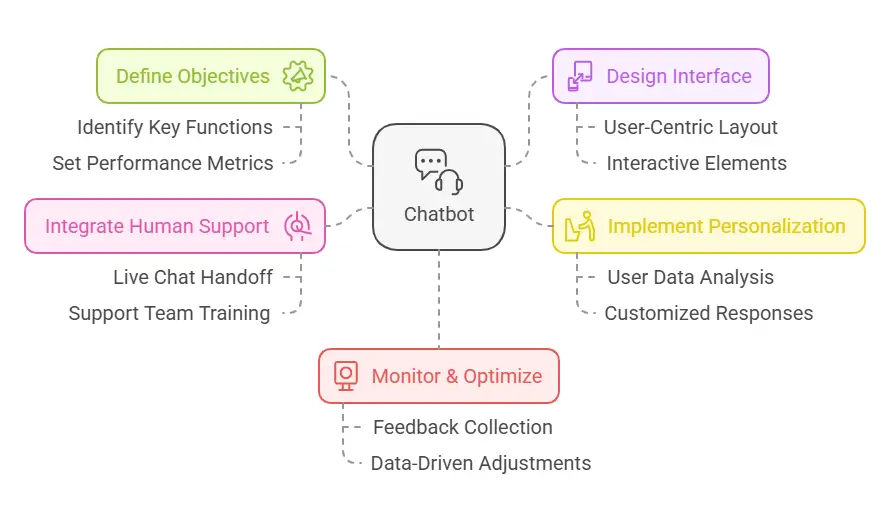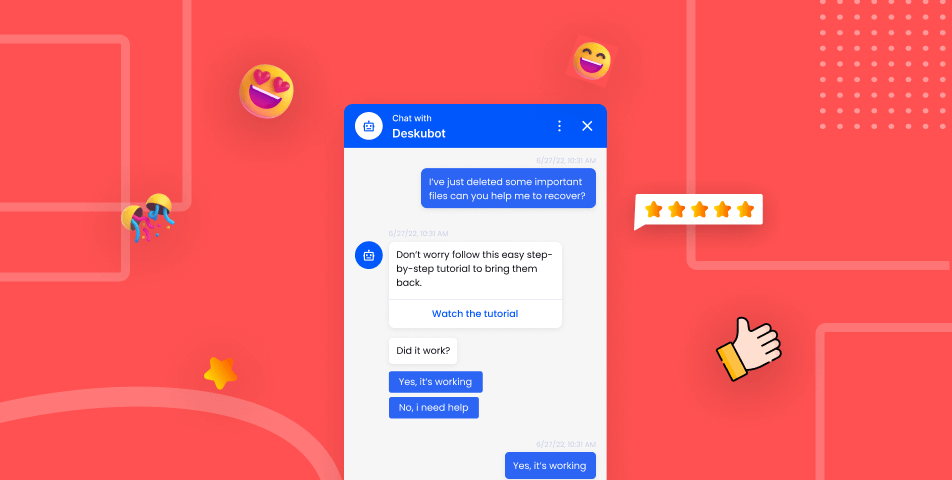Enhancing customer engagement is crucial for developing a loyal customer base and addressing customer needs. Chatbots have become vital tools for improving the customer journey, providing businesses with opportunities to implement effective engagement strategies that foster customer satisfaction and retention.
In this article, we will discuss ways to enhance customer engagement using chatbots by focusing on strategies such as personalizing interactions, monitoring customer engagement metrics, and collecting valuable insights. Whether your goal is to attract new customers, retain current ones, or create a positive brand experience, these suggestions will help expand your customer base and cultivate enduring brand loyalty.
How to Improve Customer Engagement with Chatbots

Set Clear Objectives
Clearly define your goals for the chatbot. Are you looking to enhance customer retention, assist with inquiries, or elevate customer satisfaction? Having specific objectives helps in crafting a chatbot that meets your business requirements and aligns with customer expectations.
Make Conversations Personalized
Leverage customer data to customize interactions with the chatbot. Personalized greetings, tailored product suggestions, and relevant solutions make customers feel appreciated and strengthen brand loyalty.
Design a User-Friendly Experience
Create an intuitive and engaging interface. Your chatbot should be easy to navigate, visually attractive, and optimized for various platforms, including your website, app, and social media channels.
Offer Omnichannel Support
Ensure your chatbot can operate across multiple platforms for a seamless experience. Whether customers reach out via Facebook Messenger, WhatsApp, or your website, maintaining consistency fosters trust and keeps them engaged.
Provide Quick and Relevant Responses
Chatbots should address customer inquiries promptly while ensuring accuracy. Quick and relevant responses lower customer effort and enhance the overall experience.
Encourage Feedback and Continuous Improvement
Solicit customer feedback to pinpoint areas for enhancement. Regular updates and adjustments based on customer insights help keep your chatbot effective and relevant.
Integrate Human Support
For more complex issues, facilitate smooth transitions to human agents. Combining automation with a personal touch enhances customer satisfaction and fosters loyalty.
Analyze Performance Metrics
Keep track of essential engagement metrics, such as resolution times, chat lengths, and satisfaction scores. Use these insights to refine your chatbot’s performance and adapt to changing customer needs.
By implementing these strategies, businesses can engage customers more effectively, create a positive brand experience, and cultivate long-term loyalty.
Also Read : A Guide to Customer Engagement Strategies & Benefits
Best Tips for Improve Customer Engagement with Chatbots

Tip 1: Define Clear Objectives for Your Chatbot
A chatbot without well-defined goals can lead to confusion instead of enhancing customer engagement. Before you implement one, take the time to outline specific objectives that align with your business needs. Are you looking to boost customer engagement, enhance the customer experience, or support a successful customer engagement strategy? Having clear goals ensures that your chatbot effectively fulfills its intended purpose.
For instance, a chatbot designed to answer customer queries can improve satisfaction by decreasing response times. On the other hand, a chatbot aimed at promoting loyalty programs can help cultivate a loyal customer base.
When establishing objectives, consider:
- What are the main challenges your customers encounter?
- How can your chatbot lower the customer effort score?
- What role will it play in enhancing customer retention and satisfaction?
Aligning the chatbot’s purpose with your business goals not only enhances the customer journey but also fosters engaged customers who appreciate their interactions. Monitor results using customer engagement metrics to ensure your chatbot is achieving its objectives.
Tip 2: Design an Engaging and User-Friendly Interface
Your chatbot’s interface is crucial for keeping customers engaged. If the design is awkward or hard to navigate, it can frustrate users and negatively impact their experience. A smooth, intuitive design helps both potential and current customers remain interested during their interactions.
Here’s how to create a chatbot interface that truly connects:
- Keep It Simple: Make sure the chatbot communicates in a clear manner and avoids using jargon. Simple and straightforward responses enhance the customer’s view of your brand.
- Reflect Your Brand’s Personality: Adopt a tone and style that match your brand. For instance, a playful tone may be effective for a retail business, while a more professional tone is appropriate for a SaaS company.
- Use Rich Media: Add buttons, quick replies, emojis, and images. These features make interactions more engaging and boost user involvement.
- Optimize for Multiple Channels: Your chatbot should operate seamlessly across different communication platforms, including websites, apps, and social media.
A well-crafted interface not only enhances usability but also builds customer loyalty. When engaged customers find it easy to interact with your chatbot, they are more likely to return, contributing to a loyal customer base.
Tip 3: Implement Personalization Strategies
Personalization is crucial for enhancing customer engagement. Customers appreciate interactions that feel customized to their individual needs, which helps them feel valued and understood. A chatbot that incorporates personalization features can significantly improve the customer experience and build brand loyalty.
Here’s how to make your chatbot more personal:
- Leverage Customer Data: Utilize customer insights to tailor interactions. For example, greet returning customers by name or suggest products based on their previous purchases.
- Adapt to Customer Preferences: Allow users to choose their preferred language, tone, or communication style. This makes interactions more enjoyable and effective.
- Offer Relevant Content: Provide suggestions, promotions, or resources that resonate with the customer’s interests and perspective. Customized recommendations can enhance customer satisfaction and encourage repeat interactions.
For instance, an e-commerce chatbot can suggest products based on browsing history, while a SaaS chatbot can recommend tutorials based on user activity. By personalizing each stage of the customer journey, you cultivate engaged customers who trust your brand.
Monitoring metrics such as customer retention, lifetime value, and satisfaction scores can help assess the success of your personalization strategies.
Tip 4: Ensure Seamless Integration with Human Support
Even the most advanced chatbots have their limitations. To truly enhance the customer experience, it’s crucial to strike a balance between automation and the human touch. This approach ensures that your engagement strategy effectively addresses customer needs, particularly for more complex issues.
Here’s how to establish a smooth handoff process:
- Recognize Escalation Points: Equip your chatbot to detect when a query needs human assistance. For example, unresolved customer inquiries or emotionally charged situations should be directed to a support agent.
- Maintain Context: When passing an issue to a human agent, make sure to transfer the customer’s history and relevant details. This minimizes the effort required from the customer and demonstrates that you value their time.
- Be Transparent: Inform customers when they are interacting with a chatbot and when they will be connected to a human representative. Clear communication fosters trust and helps prevent frustration.
This integration keeps customers engaged and reassures them that assistance is readily available when needed. It also encourages customer loyalty, as they feel their concerns are genuinely addressed.
Utilizing customer engagement platforms that facilitate chatbot-to-human transitions can simplify this process across various channels. Merging automation with personalized human support creates a positive brand experience and enhances customer satisfaction.
Tip 5: Keep an Eye on Your Chatbot’s Performance and Make Improvements
A successful chatbot isn’t something you can just set up and forget about. It’s important to regularly monitor and update it to ensure it continues to be a valuable tool for engaging with customers. An optimized chatbot keeps users interested and helps improve customer retention over time.
Here’s how to effectively manage its performance:
- Track Key Metrics: Evaluate success by looking at customer engagement metrics such as customer satisfaction scores, customer effort scores, and resolution times. These insights will show you how well your chatbot is meeting customer expectations.
- Gather Customer Feedback: Use your chatbot to gather feedback on its performance. Ask questions like, “Did you find this conversation helpful?” or “What can we do to improve?” Direct input from both satisfied customers and those who leave can help enhance the overall experience.
- Update Regularly: Leverage analytics and feedback to pinpoint areas that need improvement. Train your chatbot to address new inquiries, adapt to shifts in customer behavior, and stay in tune with current trends in customer preferences.
- Test Across Channels: Make sure your chatbot performs effectively on different communication platforms, including your website, app, and social media.
By continuously optimizing its performance, your chatbot can better assist potential customers and offer personalized support that meets their needs. Ongoing improvements not only enhance customer loyalty but also help build a dedicated customer base and a strong customer-centric approach.
Benefits of Improved Customer Engagement with Chatbots
- 24/7 Availability: Chatbots offer support around the clock, allowing customers to engage with your business at any time, no matter their location or time zone.
- Faster Response Times: Chatbots can provide instant answers to customer inquiries, which lowers the customer effort score and enhances the overall experience.
- Personalized Interactions: By utilizing customer data, chatbots can offer customized responses, product suggestions, and solutions, leading to higher customer satisfaction and loyalty.
- Cost-Effectiveness: By automating routine tasks, chatbots lessen the need for human agents, resulting in cost savings and improved efficiency.
- Scalability: Whether you’re dealing with a few inquiries or a surge during busy periods, chatbots can easily scale to accommodate customer demands.
- Improved Customer Retention: By delivering quick and relevant support, chatbots help keep loyal customers and promote repeat business, increasing customer lifetime value.
- Valuable Customer Insights: Chatbots collect and analyze customer feedback, preferences, and behaviors, providing useful data to enhance your engagement strategy and boost customer satisfaction scores.
- Enhanced Customer Journey: Chatbots assist both potential and existing customers throughout the sales process, offering help at every step to ensure a smooth experience.
- Increased Engagement Across Channels: With the ability to connect with various platforms, chatbots help maintain consistent communication, creating a positive brand experience.
- Boosts Brand Loyalty: A well-implemented chatbot strategy plays a key role in a strong customer engagement approach, ultimately fostering long-term brand loyalty and a dedicated customer base.
Conclusion
Chatbots can be a powerful asset for enhancing customer engagement when implemented thoughtfully. By establishing clear objectives, creating a user-friendly interface, personalizing interactions, finding the right balance between automation and human assistance, and consistently refining performance, you can develop an effective customer engagement strategy that appeals to both new and returning customers.
Customers who feel engaged are more inclined to remain loyal, share valuable insights, and recommend your brand to others. With effective chatbot strategies, businesses can enhance the customer experience, boost satisfaction, and cultivate a loyal customer base that expands over time.
Now is the time to integrate chatbots into your customer-centric strategy. Begin applying these suggestions today to elevate customer engagement and propel your brand’s success forward!
FAQs
Q1: How can chatbots enhance customer engagement?
Chatbots enhance customer engagement by providing 24/7 support, delivering quick responses to inquiries, offering personalized interactions, and ensuring a seamless experience across various channels. These features improve the customer journey and strengthen brand loyalty.
Q2: What are the key metrics to track chatbot performance?
Key metrics for evaluating chatbot performance include customer satisfaction score (CSAT), customer effort score (CES), average response time, and resolution rate. These metrics provide insights into the chatbot’s effectiveness and highlight areas for improvement.
Q3: How do chatbots support personalization?
Chatbots leverage customer data such as purchase history, preferences, and past interactions to offer personalized recommendations, greetings, and solutions. This approach creates a more engaging and meaningful experience for customers interacting with your brand.
Q4: Can chatbots handle all customer queries?
No, chatbots are primarily designed to manage routine inquiries. For more complex issues, they should be programmed to seamlessly escalate the conversation to a human agent, ensuring a smooth customer experience.
Q5: How do I keep my chatbot effective over time?
To ensure ongoing effectiveness, regularly monitor customer engagement metrics, gather feedback, and update the chatbot to meet evolving customer needs and preferences. Testing across different communication channels also helps maintain a consistent experience.
Q6: How do chatbots contribute to customer retention?
By providing fast, accurate, and personalized support, chatbots minimize friction in the customer journey, enhancing satisfaction and encouraging loyal customers to return.


